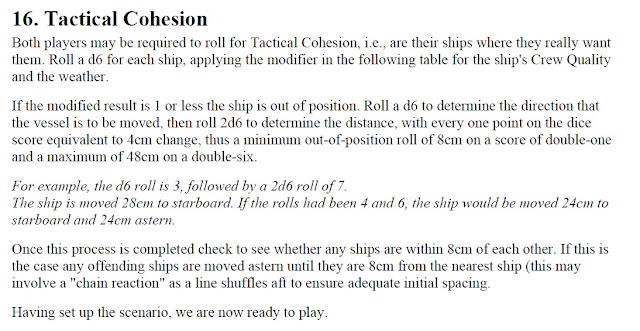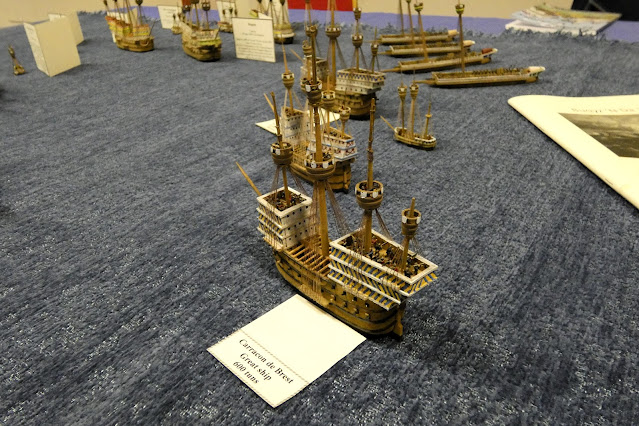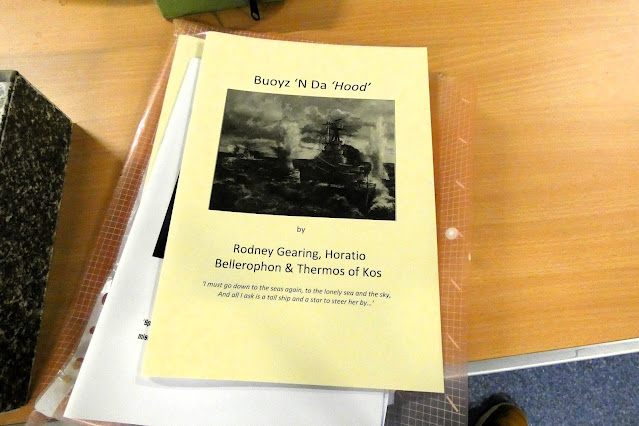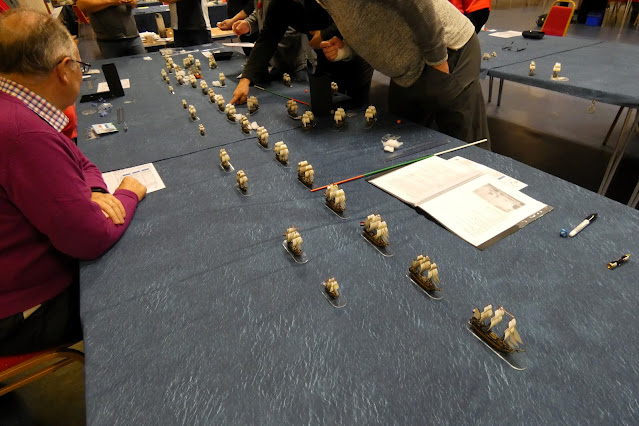Last weekend was the annual gathering of the Naval Wargames Society at the Fleet Air Arm Museum in Yeovilton, where I gathered with friends to play the Battle of Camperdown using Far Distant Ships on the Saturday as well as taking some time to get some pictures of the other games on show as fellow naval wargaming enthusiasts got together to get model ships out on the table.
This is the third occasion that I have attended the show, and last year we played Bantry Bay 1796, using Kiss Me Hardy, link below.
 |
| JJ's Wargames - Naval Wargames Society Weekend 2023 - Fleet Air Arm Museum Yeovilton |
This year, following a ten month build project, I was eagerly looking forward to running out the Camperdown collection complete on a twenty foot by ten foot table to recreate the battle fought off the Dutch coast on the 11th October 1797.
 |
| The tables are set up and the models are being put into their start positions for Camperdown |
With plenty of help on hand from our ten players, we quickly set about arranging the tables and positioning the fifty models into their start positions, recreating the British attack on the Batavian Dutch line at about 12-midday.
 |
| On the opposite twenty foot by five foot table the British are being arrayed in their two divisional groups as closer to camera on the opposite table the Batavian-Dutch line starts to take shape in readiness to receive them. |
Once things were set up and the players appointed their respective commands we had a quick briefing on the scenario objectives, specific rules and signalling, and play was soon underway.
As the British began their forty minute approach to battle moves, adjusting sail settings to make best speed towards the Batavian line, as the Batavians did their best to redress their line following several of their ships not managing to maintain their positions, I went and checked out the other games on show.
French and English Ships of the Early Sixteenth Century - Ian Armstrong
I featured Ian's collection of scratch built sixteenth century ships last year, complete with their fighting crews of sailors, gunners and longbowmen and he has added to the collection since then and these models have to be seen to really appreciate the skill and attention to detail that Ian has lavished on this project.
I think you will see that the pictures I took speak for themselves.
The Invasion of Cuba 1762 - Willz Harley
Willz was explaining to me that this game was very much a tribute to their friend and fellow enthusiast Stuart Insch who had sadly passed away this year but had produced an excellent little scenario book covering actions from the Anglo-Spanish War 1762-1763, part of the wider Seven Years War conflict, which had lots of ideas about how to stage amphibious operations as featured in this particular game.
The game depicts a British landing on Cojimar beach, Cuba, via naval landing barges and with the Spanish defending a small fort and shoreline redoubts; the game using Paul Robinson's quick play rules combined with action/event cards and 30mm Spencer Smith figures.
I have the newer version of General Quarters WWII naval rules, but I cut my teeth with both WWII and WWI naval games using the old C-in-C rules published back in the seventies with very fond memories of battleship duels knocking off floatation and gunnery boxes playing them that I was instantly reminded of with this particular game, using a set of rules that I got very familiar with back in the day.
American Civil War Participation Game
The mat and the 1:600 models would presuppose this to be a Peter Pig 'Hamerin Iron' game which I have had the pleasure of playing with fellow Devon Wargames club mates in the past.
ACW naval is very popular and has seen a resurgence of interest in recent times with increasing ranges of 3D printed models now on offer, and this game amply illustrates the potential to turn out a very attractive games with a little attention to some nice models married with an attractive table.
Buoyz 'N Da 'Hood' - Southbourne Tabletop & Boardgamers and Wessex Wyvern Wargames Clubs
Fire and Flood was the title of this game, with HMS Lannister seen here fending off an attack by unknown attack boats (probably Irristanis) in the Red Sea during Operation 'Prosperity Guardian'.
The information display below explains more about the rules designed to offer fast fun naval action.
Carrier Force - 1/600 WWII Naval Air Combat.
A new set of rules in development were on display designed to recreate carrier task forces striking at one another from over the horizon with some clever ideas using a card driven mechanism for determining spotting and the whereabouts of task forces at any given time plus submarine attacks, which the chaps were preparing to play through when I stopped to take some pictures.
The rules are in their final playtests and development with a view to publishing in the near future.
The Battle of Camperdown 11th October 1797 - Far Distant Ships, presented by the Association of Nippers and Powder Monkeys.
We started playtesting Far Distant Ships (FDS) back in January this year with another warm-up game played this month in preparation for this game, and we found the rules offer a great simulation of commanding fleets from this period of the age of sail, very much putting the players in the role of commodores and admirals rather than individual ship's captains.
If you missed those previous posts outlining the games we played earlier together with an overview of the rules plus some of the additions and tweaks I added for this game and for using them with 1:700 models you can follow the links above.
Anyone following the project to build the Camperdown collection on the blog will have seen the conclusion of that build in August and the focus shift to planning running the battle as a whole and the table plan that emerged as seen below and which formed the table arrangement for the start of our game, plus some of the scenario rules and chance cards I was intending to use, and there is a link below to my post from August covering these ideas.
 |
| JJ's Wargames - All at Sea - Battle of Camperdown, Game Planning. |
One of the key aspects of FDS is the ten minute per move scaling, and it is this scaling that enables an historical battle to be compared with the narrative of the game generated by comparing the historical clock to that of the game and the timing of events as they occured.
Thus we had the set up designed to allow both British divisions to arrive and attempt to break the Batavian line at about the same time recorded in the ships logs for that day, that would see Admiral Onslow's leeward division launch their attack at about 12.30 and Duncan's about thirty minutes later.
What was really great to see was that all the chaps had either no or a little familiarity with the rules but after a few turns of play following the sequence everyone was intuitively following along and the combat calculations were being totted up with very little need to refer to the QRS, other than to check out the results of the occasional critical hit and its associated effects.
Another of the key aspects rendered in FDS is the need to signal any changes in orders to the fleets or to specific vessels within it and to get the players up to speed with the signal flags and their respective signal books I briefed each team that they were operating to the respective signals issued by their historical counterparts.
This saw Duncan having already signalled to the British fleet to Sail large, heading East, to pass through the enemy line and to engage the enemy closely, and with De Winter having signalled to form line of battle, heading NE and to engage the enemy.
 | |
|
I then flew the respective signals for each side illustrating how they were to be arranged and read, and then had the chaps work out what had been signalled and the implications for the way they could fight their ships, which also illustrated how they needed to make signals in the game as required.
 |
| FDS has very straight forward stats for each ship that are summarised for the players on the laminated card seen on the table above and below as the Batavian commander works out his firing potential |
 |
| My Squadron information record card with everything the player/commander needs to know about his ships. |
The signalling aspect of FDS also makes the need for small ships to act as repeaters as was often their historical role in big battles and as can be seen below Admiral Duncan was making sure he had a chain of sloops, cutters, luggers and frigates between his two divisions to enable him to better coordinate the two attacks spread along the length of the Batavian line.
 |
| So often left out of tabletop and boardgame renditions of great age-of-sail battles, here the small ships of both sides are seen performing their intended roles and completing the look of the battle |
 |
| The windward division of the British fleet sporting their blue ensigns are followed into the attack by the small 28-gun frigate Circe and the 16-gun sloop Martin |
The narrative of our game followed the events of the 11th October 1797 as our game commenced at 12.00 midday, Game Turn 1 that saw the British advance from the positions illustrated on the game planner above, broad reaching and barrelling along, whilst the Batavian line plodded along, close hauled but not without two of their number failing their Tactical Cohesion test and disrupting the rear of their line.
 |
| A section of the rules explaining the potential for ships to not be where the players had intended them to be. |
This is an addition to the standard FDS rules that I have grabbed from another set of rules, but one that adds that friction to the process of what the commander has ordered possibly messed up by what his captains have managed to deliver - 'oh dear, how sad, never mind'.
The first note in the game log was at 12.42, Game Turn 4, when the Batavian Dutch fourth-rate Batavia opened fire that resulted in Admiral Duncan falling wounded. (Note the game turns work in ten minute increments and for narrative, when events occurred in the game, I simply had the players roll a d10 to discover exactly what the time was for recording in the log).
 |
| Firing becomes general among the rear most Batavian ships of the line. |
At 12.58 the Batavian fourth-rate Delft of 56-guns was stern raked by the Russell 74-guns as the latter broke the enemy line and her fire was enough for the Dutchman to haul down his colours.
 |
| Firing is breaking out along the length of the Batavian line as Duncan's windward division joins the attack |
With the Dutch rear falling into disarray as the British took advantage of the gaps in their line, Onslow was keen to press the advantage and not waste time having his third rates taking possession of struck enemy vessels and signalled the frigate Beaulieu at 13.00 Game Turn 6, to lower a boat with a boarding party to take possession of the Delft.
Meanwhile further along the Batavian line, the British windward division led by Admiral Duncan aboard his flagship Venerable was preparing to join in the attack on the Batavian van, however not before the British flagship took a particularly effective broadside from the 56-gun Batavia at 12.42, Game Turn 4 that left the 74-gun third rate with medium damage and a wounded admiral below decks.
 |
| The crew of the Speculator look on as the battle grows in intensity |
The woes for the Venerable were only compounded as she received a further broadside from the 64-gun Wassenaer three minutes later at 12.45, Game Turn 4, that was enough to cause the flagship to haul down her colours and turn away from her approach as she was passed by her consorts Triumph and Ardent to press on with the attack and allow Duncan to make preparations to transfer his flag.
 |
| The extreme end of the British windward division is brought up by the 64-gun Lancaster as the British attack proceeds with temporary command established following the loss of the Venerable |
 |
| Captain Sir Thomas Byard of the 74-gun Bedford assumes temporary command of the British windward division as the wounded Admiral Duncan transfers his flag to the frigate Circe |
The response to the wounding of their admiral was swift in coming as the two British third-rates Ardent 64-guns and Triumph 74-guns broke in among the Batavians, the former dispatching the Batavia at 13.03, Game Turn 6 with a well delivered broadside forcing an immediate strike, and with the latter passing astern of the Brutus 74-guns and flagship of Rear-Admiral Johan Bloys van Treslong commanding the Dutch blue squadron and delivering a crushing stern rake as she passed having a similar effect as that on the Batavia, with Brutus hauling down her colours at 13.05 Game Turn 6.
 |
| The panorama of our rendition of Camperdown 2024 seen from the Batavian rear that took the brunt of the initial British attack. |
Our game concluded at 13.10, Game Turn 7 with the battle well and truly under way but with me having to get back to Exmouth that evening.
We had produced a very satisfactory first big battle using FDS with plenty of drama and inspiring me to work with these rules in preparation for other games, with more time to play, say over a weekend, and no doubt much more quickly with greater familiarity.
The rules have marvellous granularity to create the narrative of these big battles but are crafted in such a way to allow the play to roll along quite speedily with no book keeping involved for the players.
Thank you to the NWS and the management of the Fleet Air Arm Museum for hosting our game. Much fun was had by all and I am looking forward to the 225th anniversary of Trafalgar, not to mention a few other ideas for future games going forward.
Until then, more anon.
JJ



















































It was a great weekend JJ and thanks for the praise and posting of my tribute game to Stuart. Your game was very impressive, sooooo tempted to do some of those ships.
ReplyDeleteWillz.
Hi Willz,
DeleteIt was indeed a lot of fun, I always enjoy the NWS at Yeovilton which is why it has become a regular date in my calendar, and I thought your game was a very nice tribute to a friend.
If you do decide to get into 1:700 AOS and you want to pick my brains about them, you can always get in touch and I'm happy to help and encourage.
All the best
JJ
Good show mate! Bravo!
ReplyDeleteHi Konstantinos,
DeleteThank you that's very kind, and pleased you enjoyed the post.
Cheers
JJ
Great day JJ.
ReplyDeleteThank you for putting on the game. Looking forward to the next one.
Regards
Peter Scott
Hi Peter,
DeleteMy pleasure.
It was great catching up with you and the chaps, and I think it might be fun to do a few more gatherings in a similar fashion, which I will turn my attention to once I'm back from my travels.
All the best mate
JJ